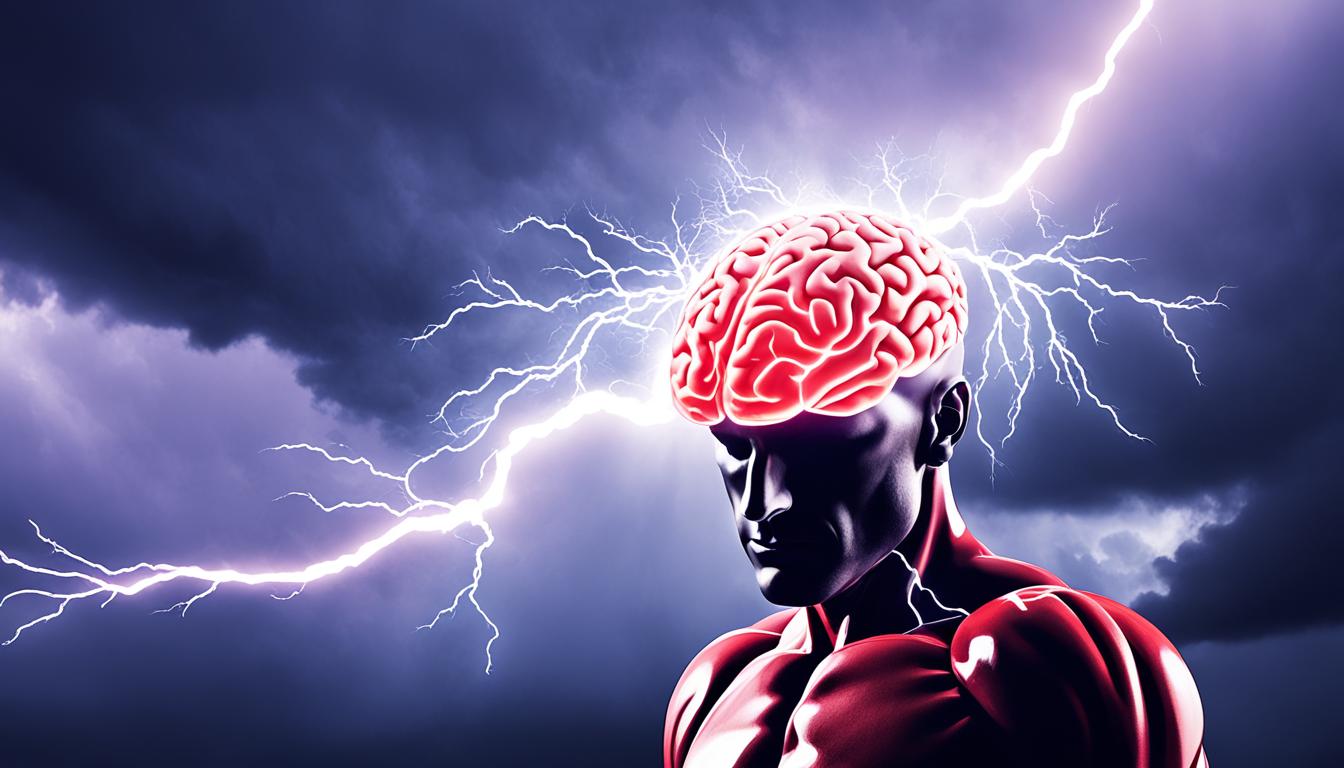Epilepsy frontal lobe disease causes seizures from the brain’s frontal lobe. It’s one common type of epilepsy. It affects many people.
The reason behind frontal lobe epilepsy is often a mystery. Yet, things like brain injuries, stroke, or infections might play a role. Signs vary but can include body jerking, not responding, and bladder problems.
Doctors diagnose epilepsy in the frontal lobe with a patient’s history and tests like EEG. Treatment involves drugs, changing diet, surgery, or neuromodulation.
Stem cell therapy is an exciting new approach for epilepsy. It uses stem cells to repair brain cells. Studies show it can reduce seizures and improve life for epilepsy patients.
Key Takeaways:
- Frontal lobe epilepsy is a neurological disorder characterized by seizures originating in the frontal lobe of the brain.
- The exact cause of frontal lobe epilepsy is often unknown, but possible factors include traumatic brain injuries, stroke, and nervous system infections.
- Symptoms of frontal lobe epilepsy can vary and may include jerking or stiffness on one side of the body, lack of responsiveness, and urinary incontinence.
- Diagnosis involves medical history, physical examination, and diagnostic tests such as EEG and brain imaging.
- Treatment options for frontal lobe seizures include medication, dietary changes, surgery, and neuromodulation therapy.
- Stem cell therapy is an innovative treatment approach that has shown promise in reducing seizures and improving quality of life for epilepsy patients.
Symptoms and Diagnosis of Frontal Lobe Epilepsy
Frontal lobe epilepsy affects a part of the brain and shows various symptoms. These can vary based on where the issue is in the frontal lobe. Symptoms might include jerking or stiffness in one body side, feeling a “wave” in your head, not responding, and trouble controlling your bladder.
Seizures in this area are usually short, under 30 seconds. After a seizure, getting back to normal can happen right away or take a few moments. These seizures can happen often, making everyday life hard and routines tough to keep up with.
Diagnosing this epilepsy needs a full look at your medical past, a body check, and special tests like an EEG and imaging scans. The past helps find out about your seizures. A check-up looks for any brain issues that might cause these seizures.
An EEG tracks your brain’s electrical activity to find the seizure’s source. MRI or CT scans can show brain problems that may be causing the epilepsy. Getting these tests is key to figure out and treat frontal lobe epilepsy correctly.
The type of seizures in the frontal lobe can include simple partial, complex partial, and secondarily generalized seizures. Simple partial seizures can cause things like muscle movements or strange feelings. Complex ones might make you lose awareness or not respond.
The last type, secondarily generalized seizures, can begin in the frontal lobe and affect both brain sides. This can lead to major body convulsions. Knowing the type of seizure you have helps plan how to treat and manage it.
Types of Frontal Lobe Seizures
| Type of Seizure | Description |
|---|---|
| Simple Partial Seizures | Affect a specific part of the frontal lobe Symptoms include motor movements or sensory experiences |
| Complex Partial Seizures | Involve a larger area of the frontal lobe Can result in altered consciousness or unresponsiveness |
| Secondarily Generalized Seizures | Start in the frontal lobe and spread to involve both sides of the brain Result in generalized convulsions |
Knowing the symptoms and types of seizures linked to frontal lobe epilepsy is vital for a correct diagnosis and plan for treatment. With a clear diagnosis, people can get the care and strategies needed to control their seizures and better their lives.
Treatment Options for Frontal Lobe Epilepsy and the Potential of Stem Cell Therapy
The main treatments for frontal lobe epilepsy mix drugs, diet changes, and possibly surgery. Antiepileptic drugs (AEDs) are often used. They help about 70% of people manage their seizures.
If AEDs don’t work, changing your diet might help. The ketogenic diet, which is low in carbs and high in fats, has improved some people’s seizure control.
Sometimes, surgery is needed. It removes the area where seizures start in the frontal lobe. This can provide a long-lasting reduction in seizures.
Neuromodulation therapy is another choice. It includes vagus nerve stimulation or deep brain stimulation. These methods can lessen seizures by changing brain activity.
Stem cell therapy is a new and hopeful option for epilepsy. It uses stem cells to repair problem areas in the brain. Early studies suggest it can lower seizures and improve life quality in those with epilepsy.
But, we need more studies on stem cell therapy’s full power and safety. It might lead to big changes in how we treat frontal lobe epilepsy. This therapy could make life better for people with epilepsy in the future.

